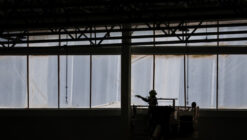8 Thoughts on Building Energy Consumption
Over the past 10 years, Allen & Hoshall has provided energy audits and facility assessments for over 3,100 facilities totaling approximately 91,500,000 sq. ft.
ASHRAE defines three levels of energy audits. Although the defining line between the various levels is generally grey, the following summaries are a starting place for developing an audit scope of work for a particular project. Often times the audits build upon each other where the lower level audit will define what the more detailed audit will focus on.
- Level 1 audits are preliminary walk-through audits. Energy usage information will be complied from utility bills and the Energy Usage Index (EUI) will be calculated and compared to similar buildings in the same region. Low or no-cost Energy Conservation Measures (ECM) will be identified as well a list of potential capital improvements to be further investigated in subsequent more detailed audits.
- Level 2 audits will include detailed energy savings calculations including consumption and demand. Savings, implementation estimates, and financial payback calculations will be performed. Many buildings can be thoroughly analyzed by a Level 2 audit.
- Level 3 audits are reserved for the complex and capital intensive ECMs. They generally include building energy modeling calibrated to the existing utility bills before simulating the changes. Installing temporary data loggers or using any existing sub metering data may be beneficial. This level may also include more intensive economic analysis.
8 THOUGHTS TO CONSIDER…
- The buildings sector, including commercial and residential, consumes more energy than any other sector. Industrial energy use is also high and quite often business demands require more transformers (like this – https://www.gbeuk.co.uk/amorphous-transformers) in place to cope.
- No conservation measure is as effective as simply turning something off. This simple concept can be applied to all energy consumption in full or in part. A few questions to ask include when can we turn off the lights, fans, process equipment, etc; is the building being over ventilated; is the ventilation being reduced when unoccupied; if the building occupancy varies during the day, can demand control ventilation be implemented?
- Have you ever regretted touching an uninsulated steam pipe or had to repair items damaged by condensation? If something is hot or cold to the touch, you can probably save energy by insulating it. These can be costly in more ways than just energy costs. Speak to a plumber about insulating your pipes to save energy – you might find ineedtheplumber.com/piping/ a useful resource.
- Feeling overwhelmed on which buildings to focus on or if your building is a good candidate for energy upgrades? A good place to start is to calculate the Energy Usage Index (EUI). This will identify which buildings are the most energy consumptive and allow you to compared them to similar buildings contained in public databases. The buildings in these databases can be filtered based on several criteria including age, usage, size, and weather regions, allowing for meaningful comparisons.
- For a successful project, buy-in from the building occupants and maintenance staff is critical. Education about the economic savings of the changes and even some friendly competition can help with both maintenance staff and occupants. Incorporating ease of maintenance into the system changes will go a long way to bringing the understaffed maintenance personal on board and can help keep those temporary energy consuming repairs from becoming permanent.
- It is often tempting to quickly implement ECMs that have short paybacks, often referred to as “low-hanging fruit.” However, grouping energy conservation measures into a comprehensive project will allow for the largest reduction in energy use and monetary savings while remaining economically viable. It’s easy to rush into a few quick projects that save a modest amount of energy with quick paybacks. But doing so can leave your facility short of its long term reduction goals without any additional projects that are economically viable on their own.
- Always investigate any incentives available from Federal, State, Local, or utility sources. There are also financing options that are available only for energy conservation projects, and considering business is being conducted, there’s also the option of looking into Business Energy packages.
- Anytime a renovation is being planned remember to include energy conservation into the planning and design. These renovations are a prime opportunity to be aggressive on reducing energy costs. Similarly, homeowners can reduce their energy costs by using comparison sites to compare their own energy plans against those of Cirro Energy to see what the most competitive rates are. During these projects the financial calculations only need to factor in the increased cost of the more efficient option over that of the lowest first-cost option and not the entire cost of the system.












